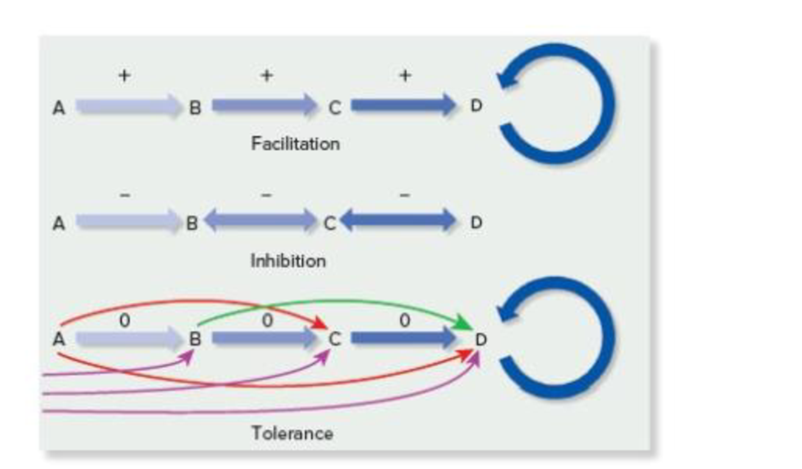
Concept explainers
Inhibition implies that competition exists between species, with early-arriving species tending to outcompete later arrivals, at least for a while. Does competition or mutualism feature more prominently in facilitation?

Figure 58.8 Three models of succession. A, B, C, and D represent four stages, with D representing the climax community. An arrow means “is replaced by,” + stands for “facilitation,” − stands for “inhibition,” and 0 indicates no effect. The facilitation model is the classic model of succession. In the inhibition model, early-arriving species outcompete later-arriving species. The tolerance model depends on which species gets there first. The colored arrows show that succession may bypass some stages in the tolerance model.
Want to see the full answer?
Check out a sample textbook solution
Chapter 58 Solutions
BIOLOGY (LL)
- Capturing and relocating is stressful for animals. In the zebra example, what are the stages of reintroduction, and what purpose does each step serve? Why is the buffalo considered a success story for reintroduction? (And -- based on what you know from lecture, what type of population growth pattern does this indicate?) Park managers use the term “adaptive management”; what do you think this means, and what are two benefits of this approach to managing ecosystems?arrow_forwardHow many species are on the far small island? Rate of Change in the Number of Species over Time 0 0 O 50 O 100 O 150 200 0 A B 50 100 # Species 150 200 C D pe g GRA Pa rimarrow_forwardWhich stage of succession has the strongest interspecific competition? First stage of succession or climax stage Which stage of succession has primarily niche pre-emption competition? First stage of succession or climax stagearrow_forward
- Why do some species tend to grow exponentially while others tend to follow a logistic growth model?arrow_forwardThe moray eel and cleaner wrasse story at the beginning of the chapter is an example of which type of community interaction? O Competition O Mutualism O Parasitism O Predationarrow_forwardDiscuss competition between species, the competitive exclusion principle, and the phenomenon of niche or resource partitioning. How do they compare and/or contrast?arrow_forward
- A community that does not undergo further succession is an apex community. True or false?arrow_forwardWhy do K-selected species tends to be successful in a climax community? Why? (answer in minimum of 500 words)arrow_forwardDiscuss the role of disturbances in moderating species diversity with relation to succession and the Intermediate Disturbance Hypothesis. You may refer to the disturbances and species diversity diagram in your discussion, and explain some of the key characteristics of r-selected and k-selected species that lead to these observed patterns.arrow_forward
- Why are priority effects considered part of the inhibition mechanism of ecological succession?arrow_forwardAn ecologist studying the availability of nutrients and the distribution of the plants that live in this habitat is working at this level. An ecologist studying the size and distribution of the Karner blue butterfly is working at this level. An ecologist studying the mutualistic relationship between the Karner blue butterfly and ants is working at this level. An ecologist studying behavior of the caterpillars when they are at different larval stages is working at this level. < Previous a Choose ] [Choose ] Community Organismal Ecosystem Population ThouT [Choose ] [Choose] No new data to save. Last checked at 6:55pm S Carrow_forwardWhich of the following can explain why species are able to coexist, even if the competitive exclusion principle is generally true? a) Species may be competitively equivalent, with the outcome of each competitive encounter being essentially random. b) Competitive exclusion may take many generations; prior to that point, there will be coexistence. c) Spatial heterogeneity in the distribution and concentrations of limiting resources can result in variation in the strength of competition across the landscape. choose all the answers that apply.arrow_forward
 Human Anatomy & Physiology (11th Edition)BiologyISBN:9780134580999Author:Elaine N. Marieb, Katja N. HoehnPublisher:PEARSON
Human Anatomy & Physiology (11th Edition)BiologyISBN:9780134580999Author:Elaine N. Marieb, Katja N. HoehnPublisher:PEARSON Biology 2eBiologyISBN:9781947172517Author:Matthew Douglas, Jung Choi, Mary Ann ClarkPublisher:OpenStax
Biology 2eBiologyISBN:9781947172517Author:Matthew Douglas, Jung Choi, Mary Ann ClarkPublisher:OpenStax Anatomy & PhysiologyBiologyISBN:9781259398629Author:McKinley, Michael P., O'loughlin, Valerie Dean, Bidle, Theresa StouterPublisher:Mcgraw Hill Education,
Anatomy & PhysiologyBiologyISBN:9781259398629Author:McKinley, Michael P., O'loughlin, Valerie Dean, Bidle, Theresa StouterPublisher:Mcgraw Hill Education, Molecular Biology of the Cell (Sixth Edition)BiologyISBN:9780815344322Author:Bruce Alberts, Alexander D. Johnson, Julian Lewis, David Morgan, Martin Raff, Keith Roberts, Peter WalterPublisher:W. W. Norton & Company
Molecular Biology of the Cell (Sixth Edition)BiologyISBN:9780815344322Author:Bruce Alberts, Alexander D. Johnson, Julian Lewis, David Morgan, Martin Raff, Keith Roberts, Peter WalterPublisher:W. W. Norton & Company Laboratory Manual For Human Anatomy & PhysiologyBiologyISBN:9781260159363Author:Martin, Terry R., Prentice-craver, CynthiaPublisher:McGraw-Hill Publishing Co.
Laboratory Manual For Human Anatomy & PhysiologyBiologyISBN:9781260159363Author:Martin, Terry R., Prentice-craver, CynthiaPublisher:McGraw-Hill Publishing Co. Inquiry Into Life (16th Edition)BiologyISBN:9781260231700Author:Sylvia S. Mader, Michael WindelspechtPublisher:McGraw Hill Education
Inquiry Into Life (16th Edition)BiologyISBN:9781260231700Author:Sylvia S. Mader, Michael WindelspechtPublisher:McGraw Hill Education





